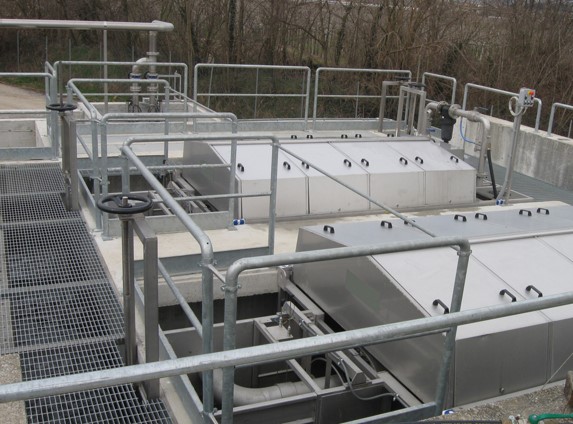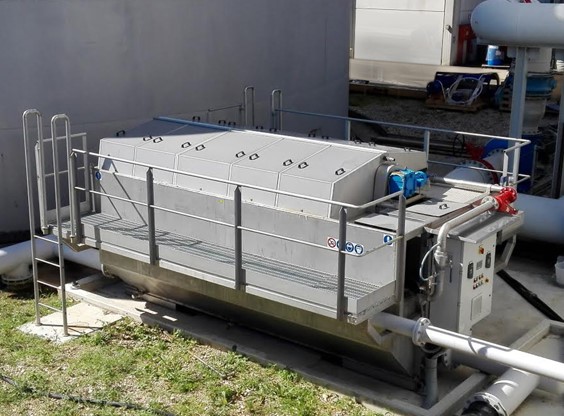Disk Filter
Years of experience in the field of tertiary treatment of waste water has led to the development of a disc filter with the highest performance, suitable for the most diverse applications for domestic and industrial installations.
The principle of filtration through the discs is extremely simple. The water to be filtered flows under free fall in the rotating central tube into the discs which are stretched on both sides with micro fabric and flows from the inside out through the panels. The solids are collected on the panels and the purified water flows through the panels. As soon as the amount of captured material increases to such an extent that clogging starts to occur on the filter plates and the liquid level in the machine starts to rise, the sieve starts to rotate so that clean surface becomes available to the water to be filtered. The collected material is rinsed from the screen and removed from the machine via a central drain.


Effluent filtration without chemicals; Without the use of chemicals, particles are separated purely on the basis of size and shape. The separation efficiency increases with an increasing suspended solids content.
Efficiency of filtration; the efficiency of the filtration is mainly influenced by the distribution of the particle size, the shape of the particles, the solids load and the flake strength. Due to the small decay over the filter cloth, the effect of the flow on the separation efficiency is low. Particles are also separated by the particle shape and the manner of the feed
Dimensioning; The combined peak is usually assumed, that means the maximum flow rate at the maximum dry matter load. When this double peak is reached, the filter rotates continuously and the disc filters are continuously cleaned.
Application of disk filters
Effective treatment of the complete effluent stream
Low energy consumption
Low investment costs
Application without coagulation or flocculation
Disk Filter
Years of experience in the field of tertiary treatment of waste water has led to the development of a disc filter with the highest performance, suitable for the most diverse applications for domestic and industrial installations.
The principle of filtration through the discs is extremely simple. The water to be filtered flows under free fall in the rotating central tube into the discs which are stretched on both sides with micro fabric and flows from the inside out through the panels. The solids are collected on the panels and the purified water flows through the panels. As soon as the amount of captured material increases to such an extent that clogging starts to occur on the filter plates and the liquid level in the machine starts to rise, the sieve starts to rotate so that clean surface becomes available to the water to be filtered. The collected material is rinsed from the screen and removed from the machine via a central drain.

Effluent filtration without chemicals; Without the use of chemicals, particles are separated purely on the basis of size and shape. The separation efficiency increases with an increasing suspended solids content.
Efficiency of filtration; the efficiency of the filtration is mainly influenced by the distribution of the particle size, the shape of the particles, the solids load and the flake strength. Due to the small decay over the filter cloth, the effect of the flow on the separation efficiency is low. Particles are also separated by the particle shape and the manner of the feed
Dimensioning; The combined peak is usually assumed, that means the maximum flow rate at the maximum dry matter load. When this double peak is reached, the filter rotates continuously and the disc filters are continuously cleaned.

Application of disk filters
Effective treatment of the complete effluent stream
Low energy consumption
Low investment costs
Application without coagulation or flocculation

 Nederlands
Nederlands Deutsch
Deutsch